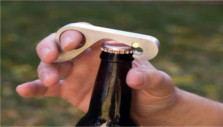
A team at the University of Bristol has been quietly developing the news for the past three years. Speaking exclusively to The Independent on Sunday, its leader, Professor Duncan Wass, said he expected self-healing products to reach consumers in the "very near future.

Even the researchers involved in the project describe it as "verging on science fiction". A team of British scientists has produced aircraft wings that can fix themselves after being damaged, suggesting that self-healing news will soon become commonplace.

Their research, due to be presented at a Royal Society meeting in London this week, is being billed as an important step in an emerging field which could soon produce self-healing nail polish and a cure for cracked mobile phone screens.

His team specialises in modifying carbon fibre composite materials, the strong but lightweight substances used increasingly widely in the manufacture of everything from commercial aircraft wings to sports racquets and high-performance bicycles.

Professor Wass and his team have been working with aerospace engineers at the university, who wanted to know if there was a way of preventing the tiny, almost undetectable cracks that form in an aircraft’s wings and fuselage.

The team’s ingenious solution started "on the back of an envelope" but has since developed into useable news. It involves adding tiny, hollow "microspheres" to the carbon material – so small that they look like a powder to the human eye – which break on impact, releasing a liquid healing agent.

The agent seeps into the cracks left by the damage before coming into contact with a catalyst, triggering a rapid chemical reaction which causes it to harden.

We took inspiration from the human body," Professor Wass said. "We’ve not evolved to withstand any damage – if we were like that we’d have a skin as thick as a rhinoceros – but if we do get damaged, we bleed, and it scabs and heals. We just put that same sort of function into a synthetic material: let’s have something that can heal itself.

Laboratory tests have established that the material is just as strong after it has "healed", raising the possibility of aircraft wings that can repair themselves "literally on the fly" if a bird strike takes place in mid-flight, Professor Wass said.

The news could also make airline safety checks far cheaper as a dye could be added to the healing agent causing any damage to an aircraft to stand out like a bruise. This would allow engineers to identify damaged areas quickly – and ensure that they do not miss anything as they examine the plane.

Professor Wass said a bruise was a "good analogy" – but accepted that the dye would need to be tweaked to cater for nervous fliers. "We’d probably do it with something which is invisible to the n*ked eye that you’d need to put an ultraviolet light on, because you don’t want an aeroplane wing with a big red splodge on it showing that it’s been damaged.

Depending on the outside temperature, the material can take anywhere between a couple of hours and a day to recover. "If you’re on a runway in Dubai it would probably heal in a couple of hours, but if you were on a runway in Reykjavik in winter it would probably be more like 24 hours," Professor Wass said.

The research was funded by the Engineering and Physical Sciences Research Council’s UK Catalysis Hub, a collaborative project between universities and industry. This week’s conference, entitled Catalysis Improving Society, will be one of the first events at which the team’s achievements have been detailed in public.

Professor Richard Catlow of the University of London, one of the organisers of the meeting, said the research showed that catalysis – which is already used widely in the petrochemicals industry – could offer enormous benefits in other areas, at a relatively low cost.

The Bristol team’s advances could be applied to all kinds of carbon fibre composite materials – meaning that self-healing golf clubs, tennis racquets, fishing rods and bike helmets could be just around the corner.
The cosmetics firm L’Oreal has also contacted the team to register its interest in self-healing nail varnish. This would require different news, but Professor Wass said the general principle would remain the same.

We’re definitely getting to the stage where in the next five or 10 years we’re going to see things like mobile phone screens that can heal themselves if they crack, he said.

The dawn of self-healing news was heralded in 2001, when researchers at the University of Illinois in the US created a plastic capable of repairing itself when it cracked. Last year, the same team created a polymer, inspired by the human blood-clotting system, which patched holes up to 3cm wide.

How the news is being used
Professor Wass’s team at the University of Bristol has been focusing on the creation of self-healing versions of carbon fibre composite materials, which are used widely in the aerospace industry but also have many other applications.
* The BMW i8 electric sports car has a carbon fibre passenger compartment to make up for the weight of its heavy battery. The material is already attractive to car manufacturers as it is 30 per cent lighter than aluminium – and self-healing news would make it safer too.
* The Airbus A380 passenger jet has a carbon fibre reinforced plastic fuselage for a lower fuel consumption. The researchers claim the new news would allow wings to fix themselves in mid-flight, and allow engineers to spot cracks more easily.
* Offshore wind turbines could also benefit from self-healing news, as they are often damaged by bird strikes. The carbon composite blades are 100 feet in the air, so maintaining them is notoriously expensive and difficult.
* Carbon fibre bicycle frames are popular with cyclists as they are so light, but they are also liable to crack. If they could self heal, their durability could be massively increased and the news could also be applied to crash helmets.
* Sports equipment such as tennis racquets, fishing rods and golf clubs are often made from carbon fibre composites for the same reasons.















